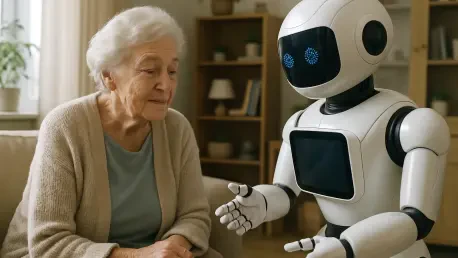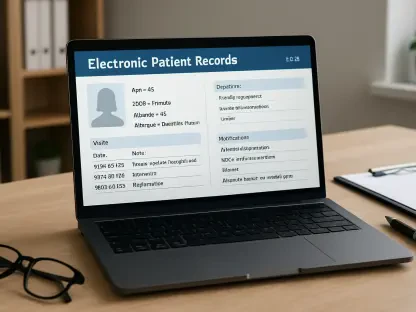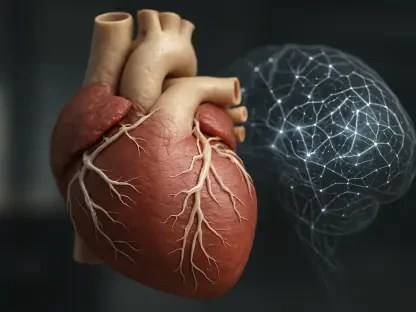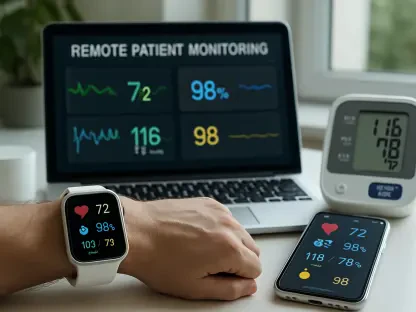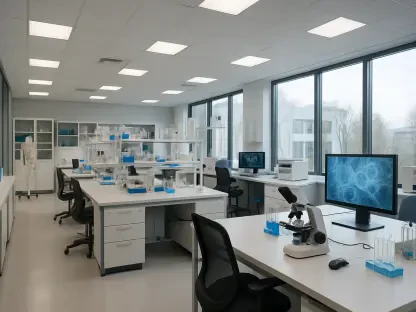In an era where healthcare systems worldwide are stretched to their limits by aging populations, escalating patient numbers, and chronic staff shortages, a quiet technological revolution is unfolding that promises to transform the industry. Hospitals and care homes, often operating under intense pressure, are witnessing medical professionals burdened by repetitive tasks and physical demands that sap their energy and time. Healthcare robots have emerged as a transformative force, not to replace human caregivers but to support them by managing routine, hazardous, or logistical responsibilities. These machines are redefining operational efficiency, enabling staff to prioritize the heart of their mission: delivering compassionate, direct patient care. From autonomous delivery systems to disinfection units, the impact of these robots is already tangible, offering a glimpse into a future where technology and humanity collaborate seamlessly to improve medical outcomes.
Imagine a bustling hospital ward where nurses no longer risk back injuries from lifting patients, or where critical medications and supplies arrive precisely on time, ferried by autonomous carts navigating complex hallways. This is no longer a distant dream but a growing reality, as healthcare robots step in to handle tasks that once consumed valuable staff hours. Their significance became especially evident during the COVID-19 pandemic, when minimizing exposure to infectious environments became a critical priority. By taking on roles like sanitizing spaces and facilitating remote consultations, these robots are proving to be vital partners in maintaining high care standards while safeguarding the health of medical teams. Their presence is not just a convenience but a necessity in addressing the mounting challenges facing modern healthcare facilities.
The scope of healthcare robots extends far beyond easing staff workloads; they are also reshaping the patient experience in profound ways. For individuals in care homes grappling with loneliness, social robots provide a source of interaction and emotional uplift, filling gaps that human staff may struggle to address amidst packed schedules. Meanwhile, mobility robots assist patients in rehabilitation, fostering independence and dignity by reducing the need for manual handling. This dual benefit—supporting both caregivers and those they serve—positions robotics as a foundational element in the evolution of healthcare systems. As adoption grows, the potential to transform daily operations and long-term care strategies becomes increasingly clear, promising a more sustainable approach to medicine.
The Role of Healthcare Robots in Modern Medicine
Addressing Staff Challenges
Easing Physical and Logistical Burdens
Healthcare robots are stepping into the fray to alleviate some of the most grueling physical demands placed on medical staff, particularly nurses who face high rates of workplace injuries. Tasks such as lifting and repositioning patients, often done multiple times a day, pose significant risks of musculoskeletal damage. Robots designed for patient mobility are now handling these transfers with precision, moving individuals between beds and wheelchairs safely, thus protecting staff from harm. Beyond physical relief, these machines also tackle logistical inefficiencies by automating the delivery of supplies, medications, and meals across sprawling hospital complexes. This saves countless hours that nurses would otherwise spend navigating corridors, allowing them to redirect their focus to critical clinical interactions and patient monitoring, ultimately enhancing the quality of care provided in high-pressure environments.
Another dimension of this support lies in how robots streamline hospital operations through integration with digital systems. Autonomous delivery units, for instance, connect with cloud-based inventory platforms to track supplies in real time, ensuring that shortages are flagged before they become crises. This not only reduces the mental load on staff who juggle multiple responsibilities but also minimizes errors in resource allocation. By taking on these repetitive and time-intensive tasks, robots free up medical professionals to engage more deeply in decision-making and personalized care plans. The ripple effect is a more efficient workflow where staff can operate at their best, unencumbered by the mundane chores that once dominated their schedules. As hospitals adopt these technologies, the potential for reducing burnout among caregivers becomes a compelling incentive for broader implementation.
Minimizing Health Risks
The role of healthcare robots in safeguarding staff from health risks has taken on heightened importance following global health crises like the COVID-19 pandemic. Disinfection robots, equipped with UV-C light or chemical spray systems, have become critical tools in maintaining sterile environments within medical facilities. These machines can sanitize wards, operating rooms, and common areas more thoroughly and consistently than manual methods, significantly cutting down the risk of pathogen exposure for healthcare workers. Their ability to operate autonomously ensures that high-risk zones are addressed without requiring staff to enter potentially contaminated spaces, a factor that proved invaluable during peak infection waves when protective measures were paramount.
Moreover, the deployment of such robots extends beyond immediate crisis response to long-term infection control strategies. Hospitals are increasingly relying on these systems to uphold rigorous cleanliness standards, especially in areas prone to outbreaks like intensive care units. By automating disinfection, facilities can maintain a safer workplace for staff while also reassuring patients and visitors about hygiene protocols. This technology not only protects physical health but also contributes to a sense of security among medical teams who often bear the brunt of infectious disease risks. As these robots become more advanced, their integration into daily routines promises to fortify healthcare settings against future public health challenges, ensuring that staff can focus on care delivery without the looming threat of avoidable illness.
Enhancing Patient Care
Improving Mobility and Independence
For patients navigating recovery or managing chronic conditions, healthcare robots offer a lifeline by enhancing mobility and fostering independence. Patient-lifting robots, engineered to assist with transfers between beds, chairs, and rehabilitation equipment, are reducing the physical strain on both individuals and caregivers. Unlike traditional manual methods, these machines provide a smoother, more dignified experience, allowing patients to maintain a sense of autonomy during vulnerable moments. In rehabilitation settings, robotic systems guide individuals through tailored exercises, supporting muscle recovery and coordination while minimizing the risk of falls or further injury, thus empowering them to reclaim control over their daily movements.
The impact of these technologies on patient well-being cannot be overstated, as they address not just physical needs but also psychological barriers. Feeling less dependent on others for basic tasks can significantly boost confidence and morale, particularly for those in long-term care. Hospitals and care homes adopting mobility robots report improved patient satisfaction, as individuals experience greater privacy and self-reliance during transfers or therapy sessions. Furthermore, these robots allow staff to allocate more time to monitoring progress and providing emotional support, creating a more holistic care environment. As these tools become more accessible, their role in promoting recovery and independence is set to redefine standards of patient care across diverse medical settings.
Combating Isolation
In elder care facilities, where loneliness often weighs heavily on residents, social and telepresence robots are emerging as powerful allies in combating emotional isolation. These machines, programmed to engage through conversation, games, or even simple companionship, offer a semblance of connection for patients who may lack regular interaction due to staff constraints or family distance. Their presence helps alleviate feelings of neglect, providing consistent engagement that can improve mental health outcomes. For many seniors, a robot’s friendly interaction serves as a daily highlight, bridging the gap between sparse human visits and fostering a sense of being valued.
Equally significant is the capability of telepresence robots to facilitate remote consultations and family connections, ensuring that patients remain linked to their support networks. Doctors can assess conditions or provide guidance without needing to be physically present, a boon for rural or understaffed facilities. Meanwhile, patients can video-call loved ones through these systems, maintaining vital emotional ties that aid in recovery and well-being. This dual functionality underscores the versatility of such robots in addressing both medical and social needs. As loneliness continues to be recognized as a critical health factor, the adoption of these technologies in care homes signals a shift toward more compassionate, tech-enhanced environments that prioritize emotional health alongside physical health.
Industry Trends and Innovations
Market Growth and Collaboration
Rapid Expansion
The healthcare robotics market is experiencing unprecedented growth, fueled by an urgent demand for solutions in logistics, mobility, and patient support. Analysts project that this sector will surpass $15 billion within the next decade, reflecting a surge in investments from both established corporations and nimble startups. This expansion is driven by the pressing need to address staff shortages and rising healthcare costs, with robots offering scalable ways to enhance efficiency. From autonomous delivery systems to advanced disinfection units, the applications are vast, catering to diverse needs across hospitals and care facilities worldwide. This momentum signals a transformative shift, as robotics becomes a cornerstone of modern medical infrastructure, promising to alleviate systemic pressures.
Behind this rapid rise lies a growing recognition of robotics as a viable long-term investment for healthcare providers. Governments and private institutions are channeling funds into pilot programs and full-scale deployments, encouraged by early success stories of reduced staff injuries and improved patient outcomes. The market’s trajectory also benefits from increasing public acceptance of automated solutions in sensitive environments like hospitals, where trust in technology is steadily building. As more facilities witness the tangible benefits—such as streamlined operations and safer workplaces—the pace of adoption is expected to accelerate, positioning robotics as an integral part of healthcare’s future landscape over the coming years.
Integrated Ecosystems
A defining trend in healthcare robotics is the move toward integrated ecosystems, where standalone machines evolve into components of broader automation platforms. Partnerships between robotics companies and tech giants are creating seamless workflows, connecting robots to cloud-based systems like pharmacy management and electronic health records. Such collaborations ensure that delivery robots, for instance, sync with hospital inventories for real-time updates, preventing delays in critical supply chains. This interconnected approach maximizes efficiency, allowing medical facilities to operate as cohesive units where technology and human effort align effortlessly to meet patient and staff needs.
These integrated systems also pave the way for scalability, as hospitals can expand robotic deployments without overhauling existing infrastructure. By linking robots with digital tools, facilities gain actionable insights into operational bottlenecks, enabling data-driven improvements. This synergy is evident in initiatives where multiple robot types—delivery, disinfection, and telepresence—work in tandem under unified software, reducing redundancy and enhancing coordination. As these ecosystems mature, they promise to embed robotics deeper into daily hospital routines, fostering environments where automation supports rather than disrupts the critical human elements of caregiving, ensuring a balanced and effective approach.
Future Technological Advancements
AI and Multi-Functionality
The horizon of healthcare robotics is being reshaped by artificial intelligence (AI) and machine vision, technologies poised to elevate robots from single-purpose tools to versatile assistants. AI enables these machines to learn from their environments, adapting to complex hospital layouts or patient behaviors over time. This means a robot initially designed for medication delivery could, with software upgrades, also monitor ward cleanliness or assist in telepresence consultations. Such multi-functionality reduces the need for multiple specialized units, optimizing space and cost for facilities while amplifying the impact of each robotic system within daily operations.
Equally transformative is the role of machine vision, which equips robots with enhanced perception to navigate crowded spaces or recognize specific items and individuals. This capability ensures safer interactions in dynamic settings, preventing collisions and improving task accuracy. As these technologies advance, the potential for robots to handle diverse responsibilities—from logistical support to basic patient monitoring—grows exponentially. Hospitals stand to benefit from streamlined processes where a single robot can pivot between roles as needs shift, heralding a future of flexible, intelligent automation that complements human staff in increasingly sophisticated ways.
Scaling Adoption with Balance
As healthcare robots become more capable through technological advancements, the focus shifts to scaling their adoption while preserving the human essence of caregiving. The integration of AI-driven systems must be matched by robust training programs to ensure staff are comfortable and confident in collaborating with these machines. Addressing affordability remains critical, as high upfront costs can deter smaller facilities from embracing robotics, potentially widening disparities in care quality. Strategic funding and phased rollouts could mitigate this, ensuring broader access to these life-changing tools across diverse healthcare settings in the coming years.
Beyond logistics, ethical considerations loom large in this scaling process. The risk of over-reliance on robots for patient interaction must be carefully managed to avoid eroding the empathy that defines quality care. Developing guidelines that prioritize human oversight in emotional and decision-making contexts will be essential. Industry leaders and policymakers must work together to strike a balance, ensuring that as robots take on more roles, they enhance rather than replace the personal connections patients rely on. This thoughtful approach to expansion builds on past efforts, which laid the groundwork for a collaborative model where technology and humanity reinforce each other, ultimately reshaping medical care for the better.
